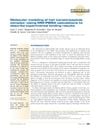Complete Structure of an Epithelial Keratin Dimer: Implications for Intermediate Filament Assembly
July 2015
in “
PLoS ONE
”
TLDR The study revealed the detailed structure of a keratin dimer, aiding understanding of how intermediate filament proteins function.
The study provided the first detailed structural models of the epithelial human K1/K10 keratin dimer, revealing insights into its tri-domain structure, comprising head, rod, and tail domains. Using 25 all-atom molecular dynamics simulations, the research highlighted the specific chirality of the rod domain and the tri-subdomain partitioning of the head and tail domains. The head domain was crucial for dimer interaction during fiber assembly, while the tail domain influenced fiber compaction. The study's models aligned with existing data on intermediate filament proteins, offering new perspectives on keratin filament formation. The research identified 214 inter-chain side-chain interactions, primarily hydrophobic, essential for maintaining the coiled-coil structure. The findings suggested a hierarchical assembly of keratin filaments, with specific dimer arrangements and twisting to maximize interfacial contact, contributing to the understanding of keratin filament assembly and function.
